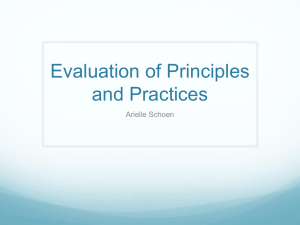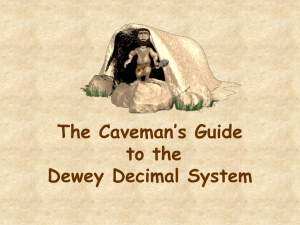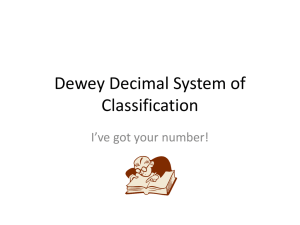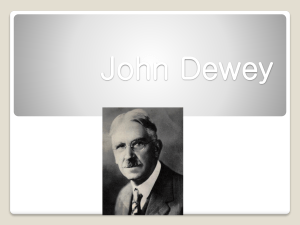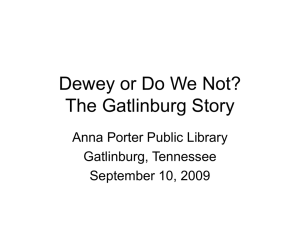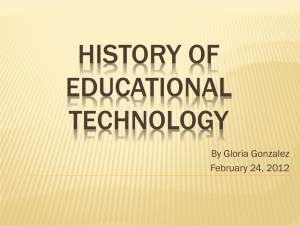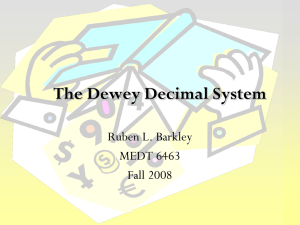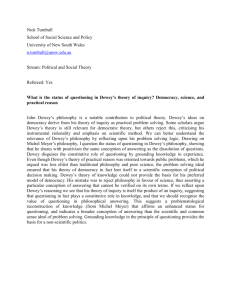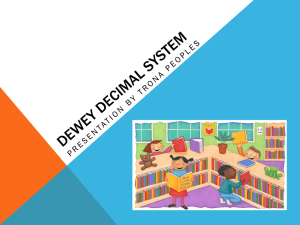File - Allison Barr E
advertisement
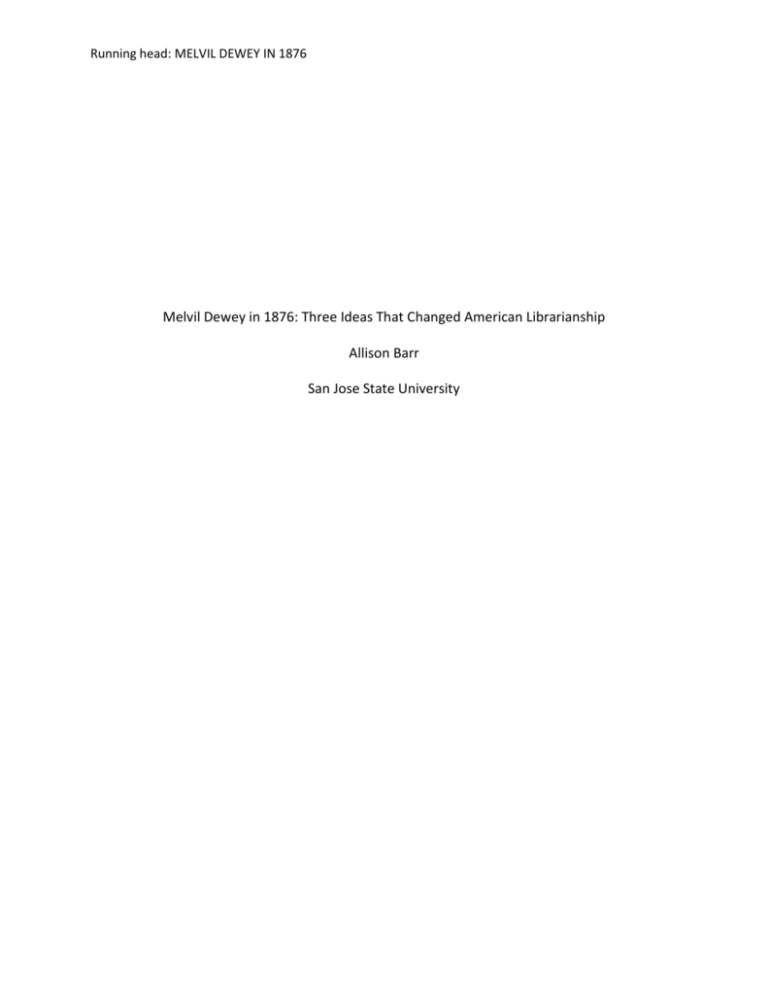
Running head: MELVIL DEWEY IN 1876 Melvil Dewey in 1876: Three Ideas That Changed American Librarianship Allison Barr San Jose State University MELVIL DEWEY IN 1876 Abstract This paper examines the accomplishments made by Melvil Dewey in the year 1876. At only 25 year old, Dewey helped found the American Library Association, founded The Library Journal, and created the Dewey Decimal Classification system. All three are still in use today. This paper describes his upbringing and time spent before 1876. As well, the controversy surrounding who truly invented the DDC is scrutinized. While Dewey may have been influenced by multiple contemporary scholars and librarians, most historians have concluded that he did not take the idea from any person. The paper concludes that although Dewey was sometimes a controversial figure, his achievements in 1876 were remarkable. 2 MELVIL DEWEY IN 1876 In this paper, the life of Melvil Dewey and his early accomplishments are examined. Although throughout his life, Dewey contributed countless ideas to the profession of librarianship (including a driving force behind the professionalization of the occupation), this paper focuses on his achievements made during the year of 1876. In 1876, at only 25 years old, Dewey helped found the American Library Association, the long running periodical The Library Journal, and also published and patented his most famous idea: the Dewey Decimal System of Classification. Almost all historical articles or books published on Melvil Dewey’s life have been large overviews that mention these events in passing. The difficulty with these biographies is that Dewey accomplished a great deal during his lifetime, as well as being embroiled in several scandals. Later in his life, Dewey was publically disgraced and rightfully denounced as a racist after he refused membership into his Lake Placid Club to the Jewish elite of New York. There was too much information to give his achievements of 1876 the full attention they deserved. All three of his ideas from that year are still in use in 2013, in one form or another. The latest edition of the Dewey Decimal System was released in 2011 and is used in at least 135 countries worldwide. The Library Journal is still in publication, and the ALA is both the oldest and the largest Library Association in the world with 62,000 members (Brichford, 1991). His life up until 1876 and his three major successes of that year are examined. This paper differs from the previous biographies and articles on Dewey by examining a small time period in depth and how the three achievements were intertwined. The first full length biography of Dewey was published in 1932, one year after his death at the Lake Placid Club in Florida. Melvil Dewey: Seer, Inspirer, Doer, 1851-1931, written by George Grosvenor Dawe was a typical authorized biography for the time period: lengthy and 3 MELVIL DEWEY IN 1876 biased. The bulk of the book was devoted to Dewey’s many achievements, but very little was mentioned of the scandals and difficulties he encountered throughout his lifetime. The “biografic” compilation (author employed Dewey’s widely unused simplified spelling), was published in Lake Placid Florida, by “Melvil Dewey Biografy”, most likely funded by the estate of Dewey himself. The next biography published was Fremont Rider’s Melvil Dewey in 1944. Thirteen years after Dewey’s death, an unbiased book was overdue. While Rider does begin his assessment by declaring Dewey a genius, he mostly succeeded in remaining impartial throughout the rest of the book. Many of the bitter rivalries are examined, such as his departure from Colombia University due to his unwavering opinion that woman will be admitted to the library school. However, Rider does not touch upon the racist scandal that plagued Dewey later in his life. Perhaps as the controversy was not directly related to librarianship it was left out, although he did delve into other parts of Dewey’s personal life. In 1945, a small backlash against Dewey began with Kurt F. Leidecker’s article “The Debt of Melvil Dewey to William Torrey Harris”. Prior to Leidecker’s article, all authors on Dewey had been in agreement that Dewey was an unmitigated genius, even with his personal flaws. In his article, Leidecker put forward that Dewey borrowed heavily for the Dewey Decimal Classification from St. Louis Public School superintendent William Torrey Harris, who developed a numerical system that was based upon Francis Bacon’s six fundamental distinctions. Dewey did not give any credit for helping or influencing his famous classification system. Leidecker demonstrated Dewey’s indebtedness by tracing the correspondence between the two men in 4 MELVIL DEWEY IN 1876 the early 1870s, before Dewey published his first classification guide. Dewey asked for any advice that Harris could spare in his endeavor to create a classification system and Dewey’s final product was very similar to Harris’ (Leidecker, 1945). Leidecker concluded that since Harris held no resentment against Dewey, no harm was done. Later authors were not so quick to forgive Dewey for his oversight. There was very little material printed on Dewey directly after the Second World War. During the 1960s and 1970s, historians began to examine Dewey’s contributions to librarianship once more. In 1968, Laurel Grotzinger published her article on Dewey’s relationship with his students, particularly Katharine Sharp, who went on to found the University of Illinois Library School. Grotzinger’s article was innovative as while Dewey was a central focus, the paper actually examined how he influenced the lives of others, and did not study his life directly. The “real” creator of the Dewey Decimal system was again investigated in John Maass’ “Who Invented Dewey’s Classification?”. Similar to Leidecker’s 1945 article, Maass’ looked into the various people that could have, and most likely did influence Dewey as he developed his classification system. Maass (1972) concluded that Dewey was likely influenced by William Phipps Blake, the scholar in charge of organizing the 30,000 exhibits at the Centennial Exhibition of 1876 (p. 335). Blake used a decimal system, and Maass claimed that Dewey had visited the Exhibition and shown great interest. In 1976, 100 years after Dewey first published his classification system, author John Phillip Comaromi published his tome, The Eighteen Editions of the Dewey Decimal Classification. In this 600 page book, Comaromi spent an entire chapter investigating who influenced Dewey, 5 MELVIL DEWEY IN 1876 based his work off of Maass’ and other historians, as well as his own personal research. Comaromi disagreed with Maass’ conclusion over Blake’s influence on Dewey, and reminded the reader that “Dewey was a genius easily capable of inventing a decimal system of classification on his own” (Comaromi, 1976, 20). A large collection of articles and essays on Dewey was published in 1978. Edited by Sarah K. Vann, the volume contains a clear bibliographic sketch of Dewey’s life and offered several resources that are difficult to obtain outside of the collection. The book also included extensive samplings of Dewey’s own work from his publish works, private journals and correspondence. Many articles and books concerning Dewey were published throughout the 1980s, beginning with Marion Caseys’s paper, “Efficiency, Taylorism, and Libraries in Progressive America”. Casey studied Dewey, in conjunction with Charles McCarthy, who developed the movement to organize legislative libraries. Again, this paper does not investigate Dewey’s life or accomplishments, but the theories, such as Taylorism, which may have inspired him. Similarly, Dierdre Stam wrote about Dewey’s relationship with his wife Annie, and their attachment to communitarianism in “Melvil and Annie Dewey and the Communitarian Ideal”. Examining theories of what may have influenced Dewey was popular during the 1980s. During the 1990s, Wayne Wiegand published his book, Irrepressible Reformer, the first full lengthy biography since the 1940s. This monograph is considered to be the definitive biography on Dewey. Wiegand delved heavily into many of Dewey’s faults, such as his anti- 6 MELVIL DEWEY IN 1876 Semitism and troubled relationships with women. He did, however, remain unbiased in his portrayal of Dewey: a flawed man, yet an unwavering genius. Since the year 2000, several articles have been published relating to Dewey, but none focused solely on him. “The Professionalization of a Calling: Mission and Method at the New York Library Club, 1885-1901”, studied the beginnings of the New York Library Club, and Dewey is discussed as one of the founding members. In Hal Grossman’s “A Comparison of the Progressive Era and the Depression Years: Societal Influences on Predictions of the Future of the Library, 1895-1940”, Dewey was scrutinized as one of the progressive librarians who called for American libraries to harness the methods of American businesses. In any history of librarianship, Melvil Dewey’s name is bound to be mentioned. As one of the early leaders, he is still arguably the most recognized name in library science. He was born on December 10, 1851 in Adams Center, New York. The youngest of five children born to Eliza and Joey Dewey, Dewey grew up in a modest home where his parents manufactured and sold boots (Vann, 1978). The Dewey family was well known in their town for being famously hard working, and his mother Eliza held a strong spiritual conviction (Wiegand, 1996, 8). Dewey grew up going to school, working at his parent’s store, and attending Baptist church. He enjoyed physical activity, and was a voracious reader from an early age (Wiegand, 1996, 8). While he considered becoming a teacher, he instead attended the Hungerford Institute at the age of 17. It was there, in 1868, a fire broke out, and Dewey risked his life to carry out as many books as he could while the fire raged throughout the building (Wiegand, 1996, 10). After recovering, Dewey left for Oneida Seminary (Vann, 1978, 23). From there he enrolled in Alfred University in 7 MELVIL DEWEY IN 1876 New York and studied for 14 weeks, then chose to enter Amherst College in 1870 (Vann, 1978, 24). Amherst College had a strong tie to Unitarianism, and had been founded to “check the progress of errors which are propagated from Cambridge (Harvard)” (Vann, 1978, 25). Dewey settled into his new college, and thought of enrolling in the physical education program as fitness and health were a staple in his life, however he decided against it (Vann, 1978, 26). He lived on campus and became a member of the Delta Kappa Epsilon fraternity, which at this time, frowned on drinking and extravagance and promoted educational activities (Wiegand, 1996, 16). As he was an avid reader, and also a poor student, Dewey spent a good deal of time at the Amherst Library. He became interested in spelling reform, as he realized the Anglo-Saxon language was so filled with spelling irregularities, it is difficult for foreigners to learn the language (Wiegand, 1996, 17). Dewey became an employee of the Library in 1872, in order to reduce his student loans, and began keep their accounts (Wiegand, 1996, 17). It was at this point he began to make notes of the irregularities in the classification systems kept in different libraries. New York State Library was “arranged alphabetically with no attention to subjects” (Vann, 1978, 28), and the Boston Public Library used a location shelving system. On May 8th, 1873, he proposed his own basic classification system to the Library Committee of Amherst College. The Library accepted the plan and ordered 200 copies to be printed immediately for students use (Comaromi, 1976, 4). In 1874, Dewey was appointed an Assistant Librarian for Amherst College, and this allowed him to complete his classification system in the library. This paper will examine the development of the DDC more closely further below. 8 MELVIL DEWEY IN 1876 Dewey has often been described as “progressive” by historians. He wished to harness the genius of the American business model for libraries across and predicted that the public library would be viewed as essential to every progressive community as a place of education (Grossman, 2011, 105). Libraries of his future would develop and evolve, allowing users to keep books as they would be cheap to produce and therefore, abundant. Dewey believed that libraries would become centralized as reasonable library managers would recognize this as the “proper” way to conduct library business (Grossman, 2011, 106). Dewey was also influenced by communitarianism, as well as the efficiency movement. Dewey grew up very close to a communitarian commune, and later showed an interest in group living when he went on to found the Lake Placid Resort (Stam, 1989, 126). Throughout his library career though, he demonstrated an interest in communitarianism by voicing his opinions on the community aspect of librarianship and his desire to centralize libraries. Additionally, Dewey was an especially efficient scholar, as evidenced by his Decimal Classification, which put heavily importance on exact scientific approaches to library science (Casey, 1981, 267). As a young adult, he had the upmost respect for an engineer’s approach to solving problems, and built upon that background belief when devising his decimal classification system. On July 9, 1874, Dewey graduated with his class of sixty-six with a Bachelors of Arts. He stayed on at Amherst College as both a student, and as Assistant Librarian in Charge of the Library (Vann, 1978, 29). The next year, a chance meeting at Harvard College Library would alter his life. It was there, in April of 1875 that he met Annie Godfrey, who was serving as Wellesley College’s librarian. Dewey was there to present his classification scheme to a Harvard librarian and Annie was on a tour (Stam, 1989, 131). They soon began their long distance courtship. 9 MELVIL DEWEY IN 1876 While not much of their correspondence has survived, in the letters that did, Annie wrote with a gentle, playful tone of teasing, to the more reserved and serious tone of Dewey. I am going to haunt you. Every night when the clock strikes ten I shall come to you in imagination, put my hand on your forehead, smooth your temples - a moment and whisper "good-night." If you dare disobey you shall hear a little voice sing softly "good-night, good night, good-night," over and over again, keeping time with the monotonous ticking of the clock. You may think it's conscience, but it's "me" and you shall know my power as a ghost. (Stam, 1989, 131) Dewey and Annie would eventually marry in 1878, and she would be a constant source of inspiration and support as a fellow librarian. She was one of only ten women who attended the formative meeting for the American Library Association, and later traveled with Dewey to England to attend the first meeting of the British Library Association (Stam, 1989, 131). In 1876, the United States was celebrating their centennial on July 4th. The centennial celebration actually did play a small role in helping Dewey achieve some of his accomplishments during the year. In April, his Decimal Classification scheme was finally published. Later that year, he would succeed in starting up the Library Journal, and would become the youngest co-founder of the American Library Association. As mentioned above, Dewey began contemplating different methods for information organization (specifically library books), while working at the Amherst Library college. Many historians have put forward that Dewey owes a great deal of gratitude to some other contemporary scholars for his Decimal system. While this paper does not claim to conclude one 10 MELVIL DEWEY IN 1876 way or another, it does examine the other men that historians have gestured to during their own research. Kurt Leidecker was the first historian to point to William Torrey Harris as an inspiration for Dewey. Harris was the superintendent of the St. Louis Public School system and a student of philosophy (Leidecker, 1945, 139). His system rests upon Sir Francis Bacon’s fundamental distinctions as they were developed in the De Augmentis Scientiarum, where all of human learning can be divided into three subject: history, poetry and philosophy (Leidecker, 1945, 140). Harris developed his idea into four main categories of Art, Science, History and Miscellany. While four categories seemed quite different than the nine categories of Dewey’s original system, the similarities are in the subcategories that Harris devised. Under Harris’ category “Science”, there was Philosophy, Social Science, Philology, Natural Science and Theology. Some of Dewey’s nine categories were Philosophy, Sociology, Philology, Natural Science and Theology. Although Dewey’s final categories were Useful Arts, Fine Arts, Literature and History, and Harris used multiple subdivisions for his Art and History categories, the similarities are striking (Leidecker, 1945, 141). Historians Leidecker, Wiegand and John Philip Comaromi, all believe that Harris’ system motivated Dewey. In his first edition of the classification, Dewey wrote: “The plan of the St. Louis Public School Library and that of the Apprentice’s Library of New York, which in some cases resemble his own, were not seen till all the essential features were decided upon, though not given to the public” (Comaromi, 1996, 13). This is unlikely, as Harris published his system in the 1870 edition of the Journal of Speculative Philosophy, which Dewey acknowledged reading in the spring of 1873 (Wiegand, 1998, 177). The day following his library scheme presentation 11 MELVIL DEWEY IN 1876 to the Amherst Library in 1873, he wrote to Harris to ask for a copy of his catalogue. This indicated that Dewey had some knowledge of Harris’ system while initially devising his scheme, and that Dewey had a copy of the catalogue for three years while he finalized his own (Comaromi, 1976, 12). If Harris held any grudge against Dewey, he did let on. As Leidecker notes, Harris and Dewey maintained a friendly correspondence throughout their lives as not only were they interested in library classifications but also with spelling reform (Leidecker, 1945, 142). Historian Comaromi (1976) also believed Dewey drew ideas from Jacob Schwartz, who worked at the New York Mercantile Library during the time that Dewey was drafting his decimal system (p. 13). Schwartz used letters to indicate his main categories, then numerals for the subcategories, then more numerals to further subdivide. To indicate spaces between the letters and numerals, Schwartz used a decimal (Comaromi, 1976, 14). Schwartz also put every book on different card, as opposed to all in one ledger, which Dewey agreed was a much more efficient system (Comaromi, 1976, 13). In 1972, John Maass questioned whether or not Dewey was influenced by another previously unknown contemporary, William Phipps Blake. In 1872, Blake was charged with the organization and arrangement of all 30,000 exhibits at the Centennial Exhibition in Philadelphia, Pennsylvania (Maass, 1972, 335). An engineer and miner by trade, Blake had developed his own scheme by midway through 1872. He proposed separating the exhibition into ten departments, subdividing those into ten groups, which were further divided into ten classes (Wiegand, 1998, 177). Blake’s system was published in 1873, and was most likely sent to Amherst, where Dewey was developing his classification (Maass, 1972, 340). 12 MELVIL DEWEY IN 1876 In John Comaromi’s book, The Eighteen Editions of the Dewey Decimal Classification, he examined all the research and claims made by other historians on who influenced Dewey. He also studied the original preface in Dewey’s first edition of the DDC. Dewey wrote: …in his varied reading, correspondence and conversation on the subject, the author doubtless received suggestions and gained ideas which it is now impossible for him to acknowledge. Perhaps the most fruitful source of ideas was the Nuovo Sistema di Catalogo Bibliografico Generale di Natale Battezzati of Milan. Certainly he is indebted to this system adopted by the Italian publishers in 1871 although he has copied nothing from it. (Comaromi, 1976, 10) Comaromi thought that Dewey mentioned his indebtedness to Battezzati, for the idea of introducing title-slip into the United States, as to protect his originality and copyright. Dewey did not mention any indebtedness to Battezzati, or anyone else for that matter, for the idea of using Arabic numerals and decimals, although those ideas had been in use in cataloguing for years (Comaromi, 1976, 18). Comaromi was of the opinion that Dewey was deliberately ignoring many of the scholars that influenced him. Dewey, however, narrated a different story. While a student at Amherst, Dewey was unimpressed by the various ways that libraries organized and catalogued their book collection (Comaromi, 1976, 3). “In visiting 50 libraries, I was astounded to find the lack of efficiency and waste of time and money in constant re-cataloguing and reclassifying made necessary by the almost universally used fixed system where a book was numbered according to the particular rom, tier, and shelf where it changed to stand on that day, instead of by class, division, and section to which it belonged yesterday, today and forever” (Dewey, 1920, 151). He began to 13 MELVIL DEWEY IN 1876 read as much as he could on the technique used at other libraries, keeping notes of his readings (Wiegand, 1998, 179). He took tours of different libraries as well, such as the Boston Public Library, and the Harvard College Library. He wrote in his notes that he had read a pamphlet entitled “A Decimal System for the Arrangement and Administration of Libraries”, and he had taken an immediate liking to the idea of merging a decimal system with library cataloguing (Wiegand, 1998, 180). While working at the Amherst Library, he spent much of his time contemplating a system that would work for not only Amherst, but all libraries. Dewey was sitting in Sunday sermon in 1873, when the idea came to him to “use decimals to number a classification of all human knowledge in print” (Comaromi, 1976, 4). His first draft was created in 1873. It proposed that all human knowledge could be divided into nine categories: Philosophy, Theology, Sociology, Philology, Natural Sciences, Useful Arts, Fine Arts, Literature and History (Wiegand, 1996, 32). All these categories would be subdivided into nine sub-classes by inserting a decimal. Further subdivision could then be added by placing a second digit after the first sub-class signifier (Wiegand, 1998, 181). Within the categories, the authors would be arranged alphabetically. He submitted his system to the Library committee at Amherst College in May of 1873, and they asked for 200 copies of his pamphlet to be printed. Dewey set to work on reorganizing and cataloguing the library (Comaromi, 1976, 5). The day following his presentation to Amherst, Dewey wrote to William Harris for copies of his classification for some outside help and perspective (Wiegand, 1998, 18). The number one priority for him was for the classification system to be clear and concise. He approached the professors and other staff at Amherst for guidance in arranging the divisions, and physically 14 MELVIL DEWEY IN 1876 re-cataloguing the library (Wiegand, 1998, 182). Wiegand summed up the classification system when he wrote that the DDC “harnessed a mid-19th century male white Western (and largely Christian) view of the world” (Wiegand, 1996, 33). In 1876, Dewey had finished and polished his first draft of the DDC. He had added in one final category, “Bibliographies, periodicals and encyclopaedias”, as well as a preface which explained the classification and index. In March of that year, he wrote to the Register of Copyrights in Washington, D.C. asking for a copyright. As he was unsure of the cost of copyrighting a work, he enclosed one dollar to cover the cost (Wiegand, 1998, 188). Dewey had been in contact with Edward Ginn, of Ginn and Company educational publishing house, and Ginn offered to buy the extra copies of the DDC and serve as publisher for all future editions (Wiegand, 1996, 30). Dewey was hired by Wellesey College in 1882 as the Library Bureau Consultant and used this time to polish his system and train others in how to implement the changes in working libraries (Wiegand, 1996, 75). The second edition of the DDC was released in 1885 with 500 copies, and had expanded the subject index from 2,000 to 14,000 entries (Wiegand, 1996, 113). Work on the third edition began immediately however, Dewey left that work to other scholars as he began to focus on new projects in his life (Wiegand, 1996, 114). In 1996, the 21st edition of the DDC was published at a hefty 4,000 pages. It is clear that Dewey did not invent his decimal system out of thin air, with no influence. Most historians who examined the evidence concluded that Dewey took the pre-existing ideas of decimal systems, categories and sub-divisions and expertly wove them together with Arabic numerals and alphabetized systems to create a classification that was easy enough to 15 MELVIL DEWEY IN 1876 implement in most libraries. Dewey asserted that classification systems were necessary to overcome the chaos of human information (Olson, 2004, 604). In 1876, he succeeded in beginning the records management reform that would someday be used by 200,000 libraries in 135 different countries throughout the world. 95% of public and school libraries use the system (Wiegand, 1998, 175). In 1876, Dewey also began two other projects that would become very important to the history of librarianship. A library convention was held in October of 1876, designed to bring together the professionals of the library science world. Not only was Dewey instrumental in organizing the convention, he was an active participant and instigator in the historical decisions made there (Glynn, 2006, 440). It was during this convention, that the American Library Association was born. Dewey welcomed the librarians to a professional status. In Maynord Brichford’s article for the ALA (1991), “The Context for a History of the American Library Association”, Dewey inspired his fellow librarians by calling them “ ‘positive, aggressive characters’ who ‘can readily produce any book asked for,’ create ‘a desire to read the best books,’ and supply school graduates ‘with reading which shall serve to educate’” (p. 351). During this first convention, the members had difficulty producing a constitution, so Dewey suggested electing an executive committee to create the document. He was named secretary and treasurer, and was the first member to sign the constitution (Wiegand, 1996, 47). This initial conference set the tone for the first 15 years of the ALA. The constitution was finalized in March of 1877 (Wiegand, 1996, 51). The original stated objective of the ALA was: “… to promote the library interest of the country by exchanging 16 MELVIL DEWEY IN 1876 views, researching conclusions, and inducing cooperation in all departments of bibliothecal science and economy; by disposing the public mind to the founding and improving of libraries; and by cultivating goodwill among its own members” (Wiegand, 1996, 51). The first annual meeting was held in September 1877, with 66 in attendance. It was not an immediate success however. Dewey was 25 and much younger than most of the members of the ALA. The executive committee quickly realized however, that Dewey and his drive and energy were necessary for the Association to succeed. He was focusing on improving library practice and not theory (Wiegand, 1996, 52). He suggested that the ALA produce an annotated bibliography of around 10,000 titles for any small library to begin their collection (Wiegand, 1996, 60). With these small ideas, the ALA began to grow into the Association it is now: over 47,000 members across the globe that promotes literacy and the professionals of library science. The final success from Dewey in 1876 was the beginning of The Library Journal. In April of that year, Dewey discussed his idea of publishing a new library journal with fellow librarians. John Eaton, the US Commissioner of Education, had approached Dewey to include his DDC in his 1876 centennial report on educational developments. Using this opportunity, Dewey allowed the DDC to be used, so long as his new journal was also included (Wiegand, 1996, 35). After this success, Dewey approached the editors Frederick Leypoldt and Richard Bowker of Publishers Weekly in New York. They struck a deal where Leypoldt would own, print and distribute the journal from New York, and Dewey would serve as editor from Boston (Glynn, 2006, 440). The first edition was published in September of 1876, and was included in the programs for the convention that would later go on to become the ALA (Wiegand, 1996, 44). The 17 MELVIL DEWEY IN 1876 Association adopted The Library Journal as their official journal. Much like the ALA, The Library Journal had an unsteady beginning. The publication lost a whopping $1100 dollars in its first year of operation. Bowker attempted to force the editor position out of Dewey’s hands, but Dewey pushed back. He threatened to start a competing journal with his ALA associates (Wiegand, 1996, 57). Bowker relented. A few years later, Leypoldt attempted to suspend the journal due to low sales, yet there was so much outrage from ALA members, it was immediately reinstated. Since then, The Library Journal has served as an outlet for librarians and members of the ALA to inform themselves on the latest news and accomplishments of their profession. Melvil Dewey left a long list of accomplishments throughout his lifetime. By the time he was 25, at the end of 1876, he had published his most famous work, the Dewey Decimal Classification, helped found the American Library Association, and began the long-running Library Journal. He went on to found the first American college for librarians, promoted women in the profession and was a zealous spelling reformer. Later he founded the Lake Placid Club, a social and recreation club in New York. Dewey was a polarizing man. He held strong viewpoints and debated often. While undoubtedly a genius, historians have questioned some of his decisions regarding the DDC as well as his personal views that came out later in life. All can agree, however, that as polarizing as he may be, there is little chance that historians will stop discussing him anytime soon. 18 MELVIL DEWEY IN 1876 Resources Bowker, R. R. (1932). Melvil Dewey: Founder and pioneer. Bulletin of the American Library Association, 26 (2), 93-94. Retrieved from: http://www.jstor.org/stable/25687571. Brichford, M. (1991). The context for a history of the American Library Association. Libraries & Culture, 26 (2), 348-356. Retrieved from: http://www.jstor.org/stable/25542341. Casey, M. (1981). Efficiency, taylorism, and libraries in progressive America. Journal of Library History, 16 (2), 265-279. Retrieved from: http://www.jstor.org.libaccess.sjlibrary.org/stable/25541194 Comaromi, J. P. (1976). The eighteen editions of the Dewey Decimal Classification. Albany, New York: Forest Press Division, Lake Placid Education Foundation. Dawe, G. G. (1932). Melvil Dewey: Seer, inspirer, doer, 1851-1931. Lake Placid Florida: Melvil Dewey Biografy. Dewey, M. (1876). Classification and subject index for cataloguing and arranging books and pamphlets of a library. Amherst, Massachussets. Dewey, M. (1920). Decimal classification beginnings. Library Journal, 45, 151-152 Frohmann, B. (1997). “Best books” and excited readers: Discursive tensions in the writings of Melvil Dewey. Libraries & Culture, 32 (3), 349-371. Retrieved from: http://www.jstor.org.libaccess.sjlibrary.org/stable/25548545 Glynn, T. (2006). The professionalization of a calling: Mission and method at the New York Library Club, 1885-1901. Libraries and the Cultural Record, 41 (4), 438-461. Retrieved from: http://www.jstor.org.libaccess.sjlibrary.org/stable/25549364 Grossman, H. B. (2011). A comparison of the progressive era and the depression years: Societal influences on predictions of the future of the library,1895-1940. Libraries and the Cultural Record, 46 (1), 102-128. Retrieved from: http://libaccess.sjlibrary.org/login?url=http://search.ebscohost.com/login.aspx?direct=t rue&db=aph&AN=59159654&site=ehost-live Grotzinger, L. A. (1968). Melvil Dewey: The sower. Journal of Library History, 3 (4), 313-328. Retrieved from: http://www.jstor.org.libaccess.sjlibrary.org/stable/25540126. 19 MELVIL DEWEY IN 1876 Hill, P. F. (1932). Melvil Dewey: a Personal View. Bulletin of the American Library Association, 26 (2), 94-95. Retrieved from: http://www.jstor.org/stable/25687572. Leidecker, K. F. (1945). The debt of Melvil Dewey to William Torrey Harris. The Library Quarterly, 15 (2), 139-142. Retrieved from: http://www.jstor.org/stable/4303322 Maack, M. N. (1998). Gender, culture, and the transformation of American librarianship, 18901920. Libraries & Culture, 33 (1), 51-61. Retrieved from: http://www.jstor.org.libaccess.sjlibrary.org/stable/2554859. Maass, J. (1972). Who invented Dewey's classification? Wilson Library Bulletin 47, 335-342. Hardcopy. Olson, H. A. (2004). The ubiquitous hierarchy: An army to overcome the threat of a mob. Library Trends, 52 (3), 604-616. Retrieved from: http://libaccess.sjlibrary.org/login?url=http://search.ebscohost.com/login.aspx?direct=t rue&db=aph&AN=12885305&site=ehost-live. Rider, F. (1944). Melvil Dewey. Chicago: American Library Association. Stam, D. C. (1989). Melvil and Annie Dewey and the communitarian ideal. Libraries & Culture, 24 (2), 125-143. Retrieved from: http://www.jstor.org.libaccess.sjlibrary.org/stable/25542137. Wiegand, W. (1996). Irrepressible reformer: A biography of Melvil Dewey. Chicago: American Library Association. Wiegand, W. (1996). Dewey declassified: A revelatory look at the “irrepressible reformer”. American Libraries, 27 (1), 54-60. Retrieved from: http://libaccess.sjlibrary.org/login?url=http://search.ebscohost.com/login.aspx?direct=t rue&db=llf&AN=502845503&site=ehost-live. Wiegand, W. A. (1998). The "Amherst Method": The origins of the Dewey Decimal Classification. Libraries & Culture, 33 (2), 175-194. Retrieved from: http://www.jstor.org/stable/25548614. 20
